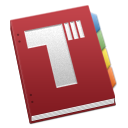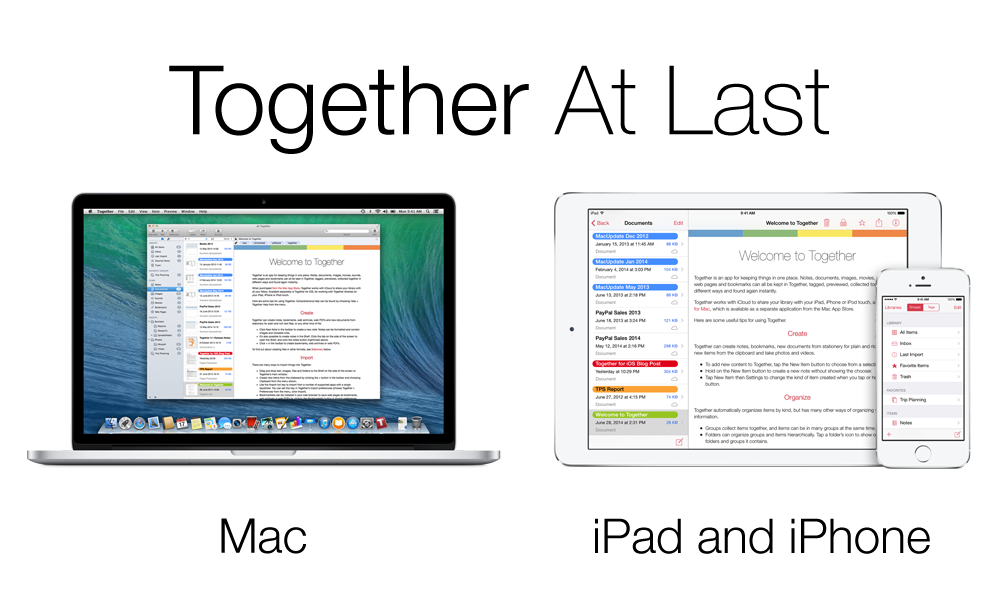 Together 3.1 is out today. This version integrates with Finder tags on OS X Mavericks, improves iCloud libraries, adds Quick Open, improves the Mini Info view, supports editing info for multiple items far more elegantly and includes a load of other improvements.
Together 3.1 is out today. This version integrates with Finder tags on OS X Mavericks, improves iCloud libraries, adds Quick Open, improves the Mini Info view, supports editing info for multiple items far more elegantly and includes a load of other improvements.
OS X Mavericks
In Mavericks, it’s now possible to tag files in the Finder and all standard Save panels. Together can fully integrate with these Finder tags so you see the same tags in the Finder as in Together and vice versa.
This integration comes in the form of two options you can enable per-library in Together’s Tags preferences: one to import Finder tags and another to update them. The import option will enable one-way interaction, where Together imports the tags for all existing and subsequent items. Meanwhile, the update option will ensure that any changes made to tags in Together are reflected in the Finder and vice versa.
iCloud Libraries (Mac App Store only)
Apple made a lot of changes to iCloud in OS X Mavericks, and so Together 3.1 is essential if you want to use iCloud libraries with the latest OS. Additionally, these improvements mean Together can now safely move whole libraries to iCloud rather than import them, and creating iCloud libraries is much faster too.
Finally, whether on Mavericks or Mountain Lion, Together now asks for a new location when moving an iCloud library out of iCloud.
Quick Open
Quick Open is a new feature that can be used to quickly open (I know!) items, groups and tags by typing. Use the keystroke Command-Shift-O to show the Quick Open panel and start typing. Items are searched by name only, so the results are very quick. Use the Up and Down arrow keys to navigate between the results without leaving the search field and hit Enter to open the selection.
Multiple Info Editor
Editing Info for multiple items in Together has had its limitations in the past, but now that the Info view appears in a pop-over, it can be more flexible. When multiple items are selected, you will now see a different view that allows you to change specific values and add or replace tags.
Mini Info
The mini info view is shown above the preview and has been improved in a few ways. The Name, Comments and Tags fields now resize with their contents, links in the Comments field are now clickable and there’s a new optional Path line for showing where an original item’s file is located.
Also, the Preview menu now always has a submenu with options to show / hide the mini Info fields or the whole view. Previously, these were only available in the View Options panel.
And more…
Text editors can now use hyphenation and vertical layout, OpenMeta tags can now be synced the same way as Mavericks’ Finder tags, the Library Manager panel has made redundant by improvements to the File > Library menu and removed completely, labels now show their color in the tag browser and there are various other improvements too. See the release notes for a full list.
Together 3.1 costs $39.99 but is a free upgrade for all Together 3.0 users. Together 2.x users can upgrade for $19.99 from this site (upgrade discounts are not available for the Mac App Store). A 15-day trial version is also available from this site.
 Following the launch of Together for iOS, the price of Together on the Mac App Store was reduced to $19.99 for four weeks as a way for people who’ve not yet upgraded to Together 3 to upgrade for the same cost as an upgrade, and for those who wanted to move from the direct version to the Mac App Store version to make the transition more affordably.
Following the launch of Together for iOS, the price of Together on the Mac App Store was reduced to $19.99 for four weeks as a way for people who’ve not yet upgraded to Together 3 to upgrade for the same cost as an upgrade, and for those who wanted to move from the direct version to the Mac App Store version to make the transition more affordably. 

